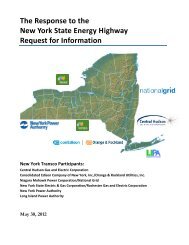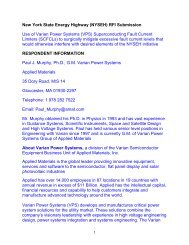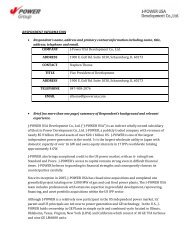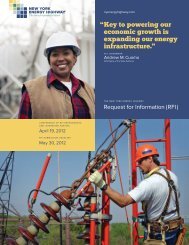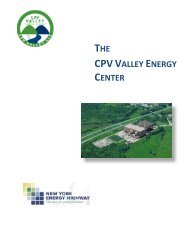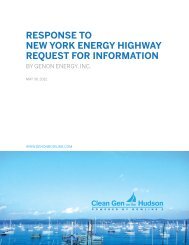Silicon Solution Joint Venture, LLC - Energy Highway
Silicon Solution Joint Venture, LLC - Energy Highway
Silicon Solution Joint Venture, LLC - Energy Highway
You also want an ePaper? Increase the reach of your titles
YUMPU automatically turns print PDFs into web optimized ePapers that Google loves.
US SOLAR – WHITE PAPER 24 May 2012<br />
Mechanism type<br />
Policy type<br />
Definition<br />
Existing or<br />
potential US<br />
solar-specific<br />
applications<br />
(potential in<br />
italics)<br />
No longer<br />
applicable<br />
Status of<br />
existing<br />
policies<br />
In force<br />
In force and<br />
expanding<br />
Unlikely to<br />
be viable<br />
Status of<br />
potential<br />
policies<br />
Viability<br />
uncertain<br />
Likely to be<br />
viable<br />
Cells highlighted in green indicate<br />
proposed policies (or existing policies<br />
that have the potential to be<br />
strengthened) which represent<br />
potential high-priority opportunities for<br />
solar industry advocates.<br />
Explanation<br />
• Net metering<br />
Solar system owner receives compensation<br />
for portion of electricity fed back into grid (ie,<br />
portion not consumed by the owner).<br />
Currently several bills pending at the federal<br />
level would mandate that utilities provide net<br />
metering, while most US states allow net<br />
metering up to a certain % of peak load<br />
(typically 1-5%)<br />
Utility<br />
regulation<br />
Restructuring<br />
regulation to support<br />
low carbon outcomes<br />
• 'Low-cost' utility<br />
regulation<br />
measures<br />
Potential 'low hanging fruit' measures<br />
adopted at the PUC level that would facilitate<br />
solar adoption include: (i) apply 'silent assent'<br />
principle to new project approval (eg, if<br />
authorities do not respond within 30 days of<br />
announced intention to develop project,<br />
developer may proceed); (ii) institute<br />
resource (solar)-specific avoided cost rates to<br />
ensure the uptake of solar generation by<br />
utilities that otherwise are required to<br />
purchase lowest avoided cost (eg, natural<br />
gas) resources. (This is different from a feedin<br />
tariff. An FiT is an incentive rate, whereas a<br />
resource-specific avoided cost is a market<br />
rate.)<br />
Equity finance mechanism<br />
Grants<br />
National<br />
laboratories<br />
National /<br />
state / local<br />
infrastructure<br />
funds<br />
Public financial aid to<br />
support low carbon<br />
outcomes<br />
Creation of national<br />
centres for research<br />
Project investment in<br />
equity or debt funds<br />
invested in clean<br />
energy projects<br />
• 1603 Treasury<br />
cash grant<br />
programme<br />
• Local / regional<br />
upfront rebates<br />
• DOE and other<br />
national lab<br />
initiatives<br />
• Public Benefit<br />
Funds<br />
Cash grant for project owner corresponding<br />
to 30% of project cost . Expired Dec 2011<br />
California (via California Solar Initiative) and<br />
Colorado among states that incentivise solar<br />
deployment by offering cash-based rebates<br />
based on system size and cost<br />
US DOE funds both technical and market<br />
research – eg, DOE SunShot Initiative to<br />
reduce total cost of energy systems (including<br />
'soft costs') by 75% by 2020<br />
A number of US states established Public<br />
Benefit Funds (PBF) for renewable energy<br />
and energy efficiency in the process of<br />
deregulating their electric utilities in the<br />
1990s.<br />
Most state PBFs expired after their initial<br />
terms, and there has been limited effort to<br />
reinstate them in the aftermath of the<br />
recession.<br />
Accelerated<br />
depreciation<br />
Granting the right to<br />
depreciate certain<br />
types of clean energy<br />
equipment over an<br />
accelerated timeframe<br />
to reduce tax<br />
liabilities<br />
• MACRS<br />
• Bonus<br />
depreciation<br />
•'Super bonus'<br />
depreciation<br />
MACRS allows for depreciation of solar asset<br />
on accelerated (6-year) schedule, compared<br />
to ~25-year project life<br />
Bonus depreciation (allows 50% depreciation<br />
in first year) is available through 2012<br />
Super bonus (100% in first year) was<br />
available in 2011<br />
Investment tax credit for project owner<br />
corresponding to 30% of project cost. In force<br />
through 2016<br />
Tax-based mechanism<br />
Investment<br />
tax credit<br />
Tax benefit based on<br />
upfront capital<br />
investment, to reduce<br />
tax paid in the early<br />
years of a project<br />
• ITC<br />
• CRA / public<br />
welfare<br />
qualification<br />
• ITC recapture<br />
and<br />
transferability<br />
Qualification of solar ITC to allow banks to<br />
count these credits for community-serving<br />
obligations<br />
Flexibility to allow change in ownership of<br />
solar projects without risking recapture of the<br />
ITC before it is fully monetised<br />
Adjustment of GAAP accounting rules to<br />
mitigate the volatility to earning statements<br />
caused by the ITC's 'lumpiness'<br />
• Effective yield<br />
accounting<br />
© Bloomberg New <strong>Energy</strong> Finance 2012<br />
Strictly no copying, forwarding, shared passwords or redistribution allowed without prior written permission<br />
of Bloomberg New <strong>Energy</strong> Finance. For more information on terms of use, please contact<br />
sales.bnef@bloomberg.net. Copyright and Disclaimer notice on page 28 applies throughout. Page 27 of 28



